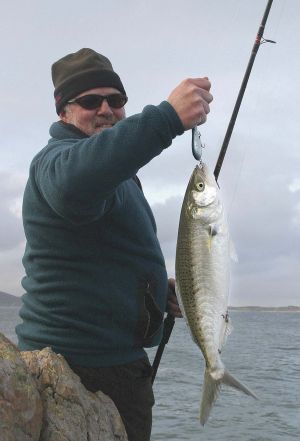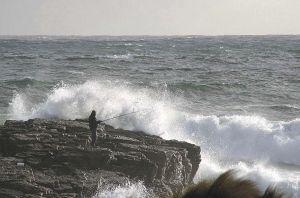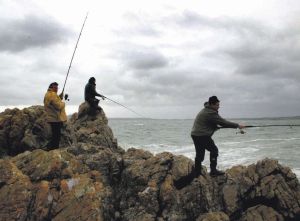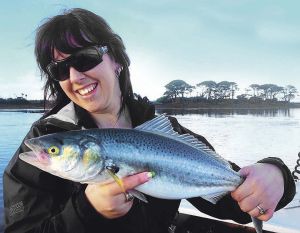 Presented from Issue 106, October 2013
Presented from Issue 106, October 2013
Whilst I have spent a lot of time fishing from the shore in recent times I have really enjoyed fishing from a kayak, so I will cover that as well.
Locations One of the absolute prime spots for Australian salmon in Tasmania is the northern part of the West Coast. You will see Marrawah on the map and close by are two of my favourite places, Nettley Bay and Sinking Rock, off the north eastern side of Green Point. These are consistently prime places as is both East and West Inlet, although I would favour West Inlet over the two.
 |
| Nettley Rock can get very rough so take care |
Nettley Bay
You can drive to Nettley Bay and Nettley Rock is straight in front of the car park. Fishes well in all tides, but it can be really wet from the spray that comes in. It can look dangerous, but it is mostly spray rather than waves. However you should take great care and if in doubt don’t go. Any big westerly can be severe here and you will not be fishing.
People that know it fish from the side of the rock rather than the front. And the best fishing is parallel to the beach rather than trying to belt out a big cast towards South Africa. The rock is quite high and one of the trickiest things is getting your fish up and away from the kelp which surrounds the base. You must play your fish out so that you can use a wave to bring it up and then swing it onto the rock.
Lures and bait both wok well here and I have found the most productive spot is behind the breakers. So cast parallel to the beach, but along behind the breakers. Time of day doesn’t seem to matter. They are schooling fish and sometimes they are there and sometimes not. I have been there at dawn and the bite doesn’t happen until two in the afternoon.
I like a big strong 10’ rod here with a 5000 or bigger reel capable of casting a 30-70 gram lure, but I will talk about gear later. It is vital here because of the constant wind, high rock and strong fish.
 |
| The author at Sinking Rock at Marrawah A relatively safe platform and some big fish available |
Sinking Rock
This is accessed from the same car park as Nettley Bay. There is a well established track that runs north along a coastal reserve to Green Point. You cross the finger of land to Sinking Rock on the northern side. It is an easy flat walk and takes less than half an hour. This is a better spot in a westerly or south westerly. Tide does not seem to matter too much, but at some stage you will get a good run of fish.
The most consistent fishing seems to also be by fishing parallel to the shore – so fishing in a north easterly or easterly direction, rather than out of the bay. Lures similar to Nettley Rock, but also poppers and bait is a great option – especially if you want a break from casting lures. Always soak a bait while you are stopping for lunch or a coffee. Bait will often work best on the rare calm or glassy day.
Duck Bay
This is more of a boat fishery and the prime spot is Eagle Point, between Perkins Island and Seven Mile Beach. This is where the main tidal flow runs in and out of Duck Bay. This can be accessed from the shore along Seven Mile Beach.
Duck Bay is also a great place to fish from a kayak and if the salmon aren’t running you might find some good trevally or some very good flathead.
Smithton – East and West Inlets
One of my standout favourite places is West Inlet. There is a small sandy track that runs from the Stanley Road about 2 kilometres from the Bass Highway to West Inlet. You can drive your car down here, but if the tide is in turning will be difficult as there is no turning circle and no car park. Park on the road and it is only a couple of hundred metres to walk. You can launch a small dinghy here – or best of all fish West Inlet from a kayak.
Lures – hard body, slugs, slices, wobblers or soft plastics, plus bait or fly fishing from the shore is easy. If you walk north a couple of hundred metres you will find a man-made, but abandoned rock bar which runs two thirds the way across. On the back side of this you will nearly always find salmon – it just depends which way the tide is running. About two thirds tide – either running in or out is best as the water races across the top of the rocks. Size of fish varies here, but there will often be good blackback salmon of more than 1.5 kilograms. It’s not unusual to catch a fish ever cast.
I love fishing here with much lighter gear than on the west coast. My tips on gear are down further. East Inlet can be a bit more hit and miss than West Inlet, but when the fish are on it can be fantastic. There is a track to the right off Stanley Road about another kilometre further towards Stanley and there is good parking here. Take a walk over to the inlet and scope it out. The channel moves around and it is a matter of finding the deeper holes. A good running tide will be best.
Other hot spots along the North West Coast
Any river that runs into Bass Strait between Smithton and Devonport will have a run of salmon at some time between winter and Easter. I find as the winter flow drops off the fishing seems to get better. Whitebait runs does attract the fish – so from late September you will see some good action. Tide is a bit more important and I believe the fish will sit just out of the strongest current and wait for the food to come to them. Try fishing down the side of the hard current and swing your lures through to the quieter water. If I am limited to time at a river mouth I like the last hour and a half of run-in tide to about half run-out. Normally the high to the first part of run-out is best.
Most of the river mouths lend themselves to all methods – fly, lure and bait fishing. Only light gear is necessary and your trout gear will be fine.
West Coast gear
As mentioned earlier strong gear is necessary for a number of reasons. Constant wind means you will often be casting into 15 knots of breeze. That means heavier lures 30-70 grams and powerful rods. A long powerful rod of around 10 feet, is also necessary in lifting, or swinging, a big fish up onto the rocks.
There are a number of rods on the market these days that suit. Reels around 5000 or bigger in size are good and whilst I like to fish with braid it is not essential. Braid in my opinion needs to be matched with the better quality reels, which invariably have the best drag systems. Cheaper reels have drag systems that are not as smooth and you are better off with monofilament on these. Line stretch will take up the cushioning and less fish will throw the lure. Buy good quality mono and don’t go much under 20 pound. Fifteen pound braid should suffice. So please ask the tackle store what will suit you and the gear you have.
I love poppers and there are some new Strada lures in the 80-90mm range that have been getting great results on salmon. I don’t think colour matters too much. These do excite fish sometimes and seeing a big salmon smashing a popper is awesome. These are best fished with braid.

Kayak and estuary gear
Some people like the new shorter so-called kayak rods. I am not a fan and find a good strong seven foot rod is good for both kayak and shore based estuary and river mouth fishing. If I am in the kayak and a fish runs around the front of the kayak I can reach out and run the line from one side of the kayak to the other. Short rods won’t allow this.
Six or eight pound braid is what I use or up to ten pound mono. Lighter gear will let your lures have a better action – and consequently catch more fish.
Split tail minnows around three inch are great and brand does not matter too much. Some of the local Yep lures are great in the lighter silvery colours, but there are many. Jig heads in 1/8 ounce will mostly do, but at times ¼ ounce will be necessary to get down deeper or to cast into the wind. I like a good strong hook on my jig heads and a 1/0 is my choice. It is strong and gives a good hookup.
I always use a fluorocarbon leader. I am convinced this material is tougher and the fish less likely to see it. If you are bait fishing use a standard Paternoster rig with two baits on the bottom droppers and a surf popper on the top dropper. Always put a surf popper on your rig as the fish seem to love them. Best hook size is around 2/0 or 3/0 and bait can be bluebait or squid.
Best advice from me though is to visit your local tackle store – ask what fish are around and some tips on catching them.
Are they good to eat?
You bet. Australian salmon are delicious and nutritious, however they are best when looked after correctly. Kill them straight away, bleed them by cutting through the gills, keep them cool in any esky and on ice or in a slurry is best of all. The medium size fish are best and eat them within a day or two of catching. Don’t EVER freeze them.
I like mine in egg and breadcrumbs, and they are great smoked as well. Australian salmon are probably Tasmania’s most fun and easily accessed sport fish. I hope you enjoy them.
Rodney Howard
